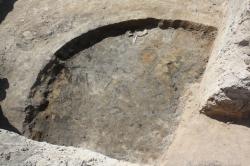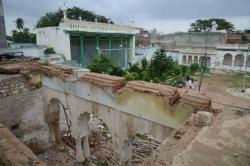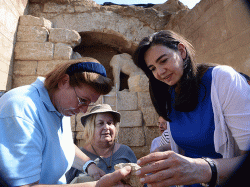INSTITUT SUPERIEUR D'ANTHROPOLOGIE
INSTITUTE OF ANTHROPOLOGY
ONLINE COURSES / COURS A DISTANCE
FALL TERM : OCTOBER 2014
REGISTER NOW
AZERBAIDJAN -  Haji Alemkhanli- An ancient settlement of the South Caucasus, referring to the Neolithic period, was discovered in Azerbaijani Tovuz region, Turkel TV regional channel reported Aug. 30. The settlement, discovered during excavations in the Haji Alemkhanli village, dates from the end of the seventh millennium BC. The excavations are conducted by Azerbaijani and Japanese archaeologists. The radiocarbon analysis of the found samples of the material culture of the Neolithic period show that the oldest settlement in the region was in this area. The first sedentary tribes lived here, the head of department at the Archaeology and Ethnography Institute of the National Academy of Sciences (ANAS) Farhad Guliyev said. "Together with Azerbaijani colleagues, we wanted to examine the Neolithic monuments in the South Caucasus," Tokyo University professor Yoshio Nishi said. "As you see, we have achieved success." Archaeological research started in 2012. According to the archaeologists, the global scientific community will be informed about the Neolithic settlement discovered in Azerbaijan. In the future, the specialists intend to appeal to UNESCO to include the finds into the World Heritage List of this organization, according to the TV channel.
Haji Alemkhanli- An ancient settlement of the South Caucasus, referring to the Neolithic period, was discovered in Azerbaijani Tovuz region, Turkel TV regional channel reported Aug. 30. The settlement, discovered during excavations in the Haji Alemkhanli village, dates from the end of the seventh millennium BC. The excavations are conducted by Azerbaijani and Japanese archaeologists. The radiocarbon analysis of the found samples of the material culture of the Neolithic period show that the oldest settlement in the region was in this area. The first sedentary tribes lived here, the head of department at the Archaeology and Ethnography Institute of the National Academy of Sciences (ANAS) Farhad Guliyev said. "Together with Azerbaijani colleagues, we wanted to examine the Neolithic monuments in the South Caucasus," Tokyo University professor Yoshio Nishi said. "As you see, we have achieved success." Archaeological research started in 2012. According to the archaeologists, the global scientific community will be informed about the Neolithic settlement discovered in Azerbaijan. In the future, the specialists intend to appeal to UNESCO to include the finds into the World Heritage List of this organization, according to the TV channel.
http://en.trend.az/azerbaijan/society/2306707.html
ROYAUME UNI - Leylodge - Archaeologists working on behalf of SHE Transmission have uncovered what is being described as ‘a discovery of national significance’ near an electrical substation at Leylodge, Kintore in Aberdeenshire. The remains of a 14/15th century medieval farm building and numerous pieces of pottery were found whilst carrying out surveys in the area. This rare find is particularly significant in terms of the cultural heritage of rural Scotland and is the latest of many finds by SHE Transmission. Working on behalf of SHE Transmission, Maureen Kilpatrick of Guard Archaeology said: “We have uncovered a large enclosure with floor deposits and pottery. Discoveries like this rarely survive in rural areas as the ground is usually used for rural purposes and is ploughed or used for cattle or livestock. This late medieval discovery is something quite special.” Bruce Mann, Archaeologist, Aberdeenshire Council, said: “Rural buildings from this period are extremely rare in Scotland, and to be able to properly investigate one through archaeological excavation will help us hugely in understanding farming life at this time.”
http://www.inverurieherald.co.uk/news/local-headlines/medieval-farm-building-uncovered-1-3522445
CHINE –  Shanggangyang - Archaeologists in Central China's Henan province have excavated a large neolithic settlement complete with moats and a cemetery. The Shanggangyang Site covers an area of 120,000 square meters and sits along a river in Zhengzhou, capital of Henan, dating 5,000 to 6,000 years back to the Yangshao culture, which was widely known for its advanced pottery-making technology. The site features two defensive moats surrounding three sides. Researchers have found relics of three large houses as well as 39 tombs, the large number suggesting several generations resided there, archaeologist Gao Zanling, a member of the Zhengzhou Administration of Cultural Heritage, said. "The size and population of the settlement, if compared with others in the same era, was pretty large," Gao told Xinhua. Excavation of the site has offered a glimpse into the life in the tribe, including the use of pits to store food or bury garbage. Researchers also found a variety of crockery wares, including pots, kettles, cups and other tools.
Shanggangyang - Archaeologists in Central China's Henan province have excavated a large neolithic settlement complete with moats and a cemetery. The Shanggangyang Site covers an area of 120,000 square meters and sits along a river in Zhengzhou, capital of Henan, dating 5,000 to 6,000 years back to the Yangshao culture, which was widely known for its advanced pottery-making technology. The site features two defensive moats surrounding three sides. Researchers have found relics of three large houses as well as 39 tombs, the large number suggesting several generations resided there, archaeologist Gao Zanling, a member of the Zhengzhou Administration of Cultural Heritage, said. "The size and population of the settlement, if compared with others in the same era, was pretty large," Gao told Xinhua. Excavation of the site has offered a glimpse into the life in the tribe, including the use of pits to store food or bury garbage. Researchers also found a variety of crockery wares, including pots, kettles, cups and other tools.
http://europe.chinadaily.com.cn/culture/2014-08/29/content_18510767.htm
INDE –  Pathergatti - While it has brought cheer to many, the incessant rain in the last two days is spelling doom for the Badshahi Ashoorkhana, the hoary monument at Patharghatti. Heavy seepage of water through the roof and walls of half-a-dozen structures in the complex pose serious danger to this protected monument. Interestingly, the Department of Archaeology and Museums has been carrying out repairs here since the last couple of months. But water continues to leak from the roof of the mini Ashoorkhana and Sarai adjacent to it, exposing the quality of work. The lime mortar plastering has come unstuck in some places and the arch pillars look totally soaked in water. Rainwater continues to stagnate on the roof of the mini Ashoorkhana and can prove hazardous to the structure. Sunday’s downpour has only heightened the threat to this house of Shia mourning built by the founder of Hyderabad, Mohammed Quli Qutb Shah, in 1594 – three years after Charminar was built. A place of tourist importance, the Badshahi Ashoorkhana is used for storing ‘Alams’ and sees hectic activity during the month of Muharram.
Pathergatti - While it has brought cheer to many, the incessant rain in the last two days is spelling doom for the Badshahi Ashoorkhana, the hoary monument at Patharghatti. Heavy seepage of water through the roof and walls of half-a-dozen structures in the complex pose serious danger to this protected monument. Interestingly, the Department of Archaeology and Museums has been carrying out repairs here since the last couple of months. But water continues to leak from the roof of the mini Ashoorkhana and Sarai adjacent to it, exposing the quality of work. The lime mortar plastering has come unstuck in some places and the arch pillars look totally soaked in water. Rainwater continues to stagnate on the roof of the mini Ashoorkhana and can prove hazardous to the structure. Sunday’s downpour has only heightened the threat to this house of Shia mourning built by the founder of Hyderabad, Mohammed Quli Qutb Shah, in 1594 – three years after Charminar was built. A place of tourist importance, the Badshahi Ashoorkhana is used for storing ‘Alams’ and sees hectic activity during the month of Muharram.
http://www.thehindu.com/news/cities/Hyderabad/rain-washes-down-the-glory-of-badshahi-ashoorkhana/article6367206.ece
USA –  Williamsburg - The remains of what is likely an 18th century on-campus brewery were discovered just outside of the nation's oldest college building when campus officials were looking to widen a sidewalk. School officials say the discovery near the Wren Building will allow them to tell a broader story about campus life in the Colonial era that involved the interaction of slaves, Native Americans, faculty and students. Records have long indicated that the college had slaves who sold the school hops that the slaves had grown on a nearby plantation. It wasn't always clear, however, exactly where that brewing was taking place after the initial campus building burned down in 1705. Based upon cannon debris found at the site, officials believe the brewery they've found only existed until the Revolutionary War. If known about by previous archaeologists, the brewery was never included in historical records or artist renderings. Instead, attention was generally focused on the main historic buildings like the Wren, which was built sometime between 1695 and 1700 and housed students and faculty, a kitchen and also served as a classroom space. After it was gutted by fire, the Wren Building was rebuilt in 1716 and debris from its construction was placed in a large pit near the building site. Sometime after that — likely in the 1720s, although the exact date isn't known — archaeologists believe the school built a small brewery right next to that trash pit. It would've provided beer for the few dozen students and faculty who were there during the Colonial era. The brewery site itself isn't large, with the brick outlines measuring 18 feet by 20 feet. A small addition measuring 18 feet by eight feet was added at some other point in time. The building's remains were found only about a foot underneath the surface in a heavily trafficked area of campus near Colonial Williamsburg where students and tourists have been snapping photos of the dig site.
Williamsburg - The remains of what is likely an 18th century on-campus brewery were discovered just outside of the nation's oldest college building when campus officials were looking to widen a sidewalk. School officials say the discovery near the Wren Building will allow them to tell a broader story about campus life in the Colonial era that involved the interaction of slaves, Native Americans, faculty and students. Records have long indicated that the college had slaves who sold the school hops that the slaves had grown on a nearby plantation. It wasn't always clear, however, exactly where that brewing was taking place after the initial campus building burned down in 1705. Based upon cannon debris found at the site, officials believe the brewery they've found only existed until the Revolutionary War. If known about by previous archaeologists, the brewery was never included in historical records or artist renderings. Instead, attention was generally focused on the main historic buildings like the Wren, which was built sometime between 1695 and 1700 and housed students and faculty, a kitchen and also served as a classroom space. After it was gutted by fire, the Wren Building was rebuilt in 1716 and debris from its construction was placed in a large pit near the building site. Sometime after that — likely in the 1720s, although the exact date isn't known — archaeologists believe the school built a small brewery right next to that trash pit. It would've provided beer for the few dozen students and faculty who were there during the Colonial era. The brewery site itself isn't large, with the brick outlines measuring 18 feet by 20 feet. A small addition measuring 18 feet by eight feet was added at some other point in time. The building's remains were found only about a foot underneath the surface in a heavily trafficked area of campus near Colonial Williamsburg where students and tourists have been snapping photos of the dig site.
http://www.therepublic.com/view/story/ab653aaf0d2a4f6789227f27db32f1cd/US--Campus-Brewery-Archaeology
GRECE –  Amphipolis - “A monument is discovered and preserved simultaneously, otherwise it is lost”. This is what Amphipolis leading excavator archaeologist Katerina Peristeri stated recently, making clear that she and her team know exactly what they are dealing with and how to proceed working in the site. “Architect Michalis Lefantzis, who is a member of Katerina Peristeri’s team knows exactly how to protect everything that has been uncovered until now”, says Lina Theodorou, an architect and the President of the Department of Architecture, Topography and Geoinformatics at the Central Macedonia Technical University, also making comments on the “sensitive colours” used by ancient Greek painters, traces of which have been found on the Amphipolis monument’s frescoes. Archaeologists are working under pressure, closely supervised by top Greek archaeological authorities. The Ministry of Culture and Sport Secretary General Lina Mendoni remains on the spot while Dr. Maria Andreadaki-Vlazaki, the Superintendant of Antiquities and Cultural Heritage General Directorate visited the site yesterday. At the same time, numerous members of the archaeological community are expressing their criticism over the project’s political exploitation, “fast track” process and press sensationalization. Through an email to Athenian newspaper “Efimerida ton Syntakton” , Anastasia Lazaridi, daughter of the late archaeologist Dimitris Lazaridis who first excavated at Amphipolis, stated her “anger and outrage over the spectacle and the verbal flamboyance of people who, due to their rank, should have been more reserved”. “Why such a delayed zeal? And since when (and this consists a hybris leading to punishment) scientific [archaeological]work is accomplished under a vigilant supervision by individuals not related to the discipline?”, she asks.
Amphipolis - “A monument is discovered and preserved simultaneously, otherwise it is lost”. This is what Amphipolis leading excavator archaeologist Katerina Peristeri stated recently, making clear that she and her team know exactly what they are dealing with and how to proceed working in the site. “Architect Michalis Lefantzis, who is a member of Katerina Peristeri’s team knows exactly how to protect everything that has been uncovered until now”, says Lina Theodorou, an architect and the President of the Department of Architecture, Topography and Geoinformatics at the Central Macedonia Technical University, also making comments on the “sensitive colours” used by ancient Greek painters, traces of which have been found on the Amphipolis monument’s frescoes. Archaeologists are working under pressure, closely supervised by top Greek archaeological authorities. The Ministry of Culture and Sport Secretary General Lina Mendoni remains on the spot while Dr. Maria Andreadaki-Vlazaki, the Superintendant of Antiquities and Cultural Heritage General Directorate visited the site yesterday. At the same time, numerous members of the archaeological community are expressing their criticism over the project’s political exploitation, “fast track” process and press sensationalization. Through an email to Athenian newspaper “Efimerida ton Syntakton” , Anastasia Lazaridi, daughter of the late archaeologist Dimitris Lazaridis who first excavated at Amphipolis, stated her “anger and outrage over the spectacle and the verbal flamboyance of people who, due to their rank, should have been more reserved”. “Why such a delayed zeal? And since when (and this consists a hybris leading to punishment) scientific [archaeological]work is accomplished under a vigilant supervision by individuals not related to the discipline?”, she asks.
http://www.archaiologia.gr/en/blog/2014/08/28/a-monument-is-discovered-and-preserved-simultaneously/